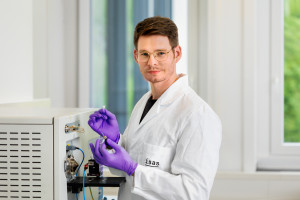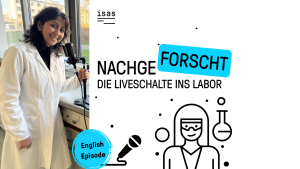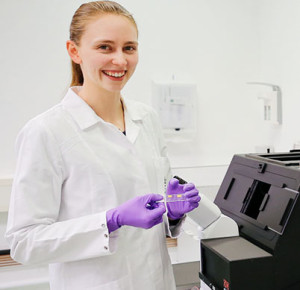Dortmund, 12th March 2025
Cholesterol is vital for the body. It serves as a building block for many hormones and is an essential component of cell membranes. However, if you have too much cholesterol in your blood, you carry a higher long-term risk of cardiovascular disease. Unfortunately, so far this hugely important health parameter has been difficult to measure. As a largely non-polar substance, cholesterol is not detected well in mass spectrometric analyses targeting the polar, i.e. water-soluble, substances in the blood. This means a separate round of analysis using a different ionisation source must be carried out to detect cholesterol. However, researchers at ISAS and the University of Vienna have now jointly developed a system allowing non-polar substances such as cholesterol together with polar substances to be detected quickly and accurately in a single step using mass spectrometry. They report on their development in Analytical Chemistry.
In mass spectrometric analysis, the constituents of blood samples are ionised, then accelerated by an electric field and separated based on their mass-to-charge ratio. Separated in this way, it is easy to determine how much of which substance is present in the blood. Polar blood components such as electrolytes are best ionised using an electrospray (see info box).
Combination method unites ionisation sources for different analytes
For non-polar substances, however, ionisation in liquids does not work sufficiently well. To detect such substances, the sample is instead usually vaporised in a thermospray at several hundred degrees Celsius and then ionised by a plasma. “In the same mea- surement, mass spectrometers can only use one ionisation source, either electrospray or plasma-based techniques,” says Dr Daniel Foest, research associate in the ISAS Miniaturisation research group and lead author of the publication. “This means you are always blind in one eye.” If researchers wish to detect non-polar substances, particularly in the lowest concentrations, this in practice means that they either need two separate devices equipped with different ionization sources or they have to convert the mass spectrometer before the second round of analysis. “We first have to disassemble one ionisation source, set up the other ion source and then recalibrate the mass spectrometer, which usually takes around an hour,” says Foest. Researchers have long been looking for a way to efficiently analyse both polar and non-polar substances in a single analysis step.

Dr Daniel Foest is a research associate in the ISAS Miniaturisation research group.
© ISAS/ Hannes Woidich
Success with two operating modes
Many researchers start with the sample and manipulate it at molecular level. However, this so-called derivatisation (see info box) is time-consuming and, in the case of cholesterol, can even falsify the analysis. In their search, the Dortmund scientists led by Foest therefore concentrated on the ionisation source. “As an approach, this may seem unusual,” says Dr Sebastian Brandt, corresponding author and former member of the ISAS Miniaturisation research group. He adds: “The ionisation source is supplied by the mass spectrometer manufacturers and is therefore a black box for many users. Our aim was to simplify the ionisation process by combining two sources in one setup.” Specifically, they attached a flexible microtube plasma (FμTP) developed at ISAS (patent pending) to a mass spectrometer already equipped with an electrospray ionisation source as standard. “With the FμTP as a hardware add-on, there are two operating modes and we can switch back and forth between them. For example, we can first ionise the polar and then the non-polar substances without having to disassemble and reassemble the mass spectrometer in between,” says Brandt in summary. When the FμTP was connected and activated, the cholesterol yield in a liver sample improved by a factor of 49 compared to conventional electrospray ionisation.
Electrospray ionisation
Electrospray ionisation (ESI) is a soft ionisation technique used in mass spectrometry. Here, a sample to be analysed is mixed with a solvent and sprayed through a fine metal capillary tube into an electrostatic field. The droplets of discharged solution repel each other electrostatically and disintegrate more and more until only floating, single, ionised molecules remain. While the solvent evaporates, the charged analyte molecules are directed into the mass spectrometer and analysed. In their study, the researchers used a so-called nano-electrospray variant (nano-ESI), which produces extremely fine droplets

Dr Sebastian Brandt is a physicist and was until recently a research associate in the ISAS Miniaturisation Research Group.
© ISAS / Hannes Woidich
Automatic temperature control optimises new hybrid variant
According to Foest, both electrospray and plasma ionisation are extremely temperature-dependent and work best in different temperature ranges. After months of tinkering, during his dissertation Foest thus developed a model in which a cooling gas on the one hand and a heating element on the other support the different ionisation steps. While in the first version the analytical chemist still had to manually switch back and forth between the two ionization sources, an electronic system now regulates this automatically. “The switching between the two ionisation sources is so fast it is almost simultaneous,” says Foest. “Both ionisation sources now work at op timum efficiency and the mass spectrometer is completely unaware of the switch,” adds Brandt.
For Foest and Brandt this combination method represents a real improvement in mass spectrometry. Not only does it save time and effort, it also allows samples in small quantities to be analysed in a single step – and therefore more efficiently. This approach is particularly useful for analysing tissue samples that are only available in extremely small quantities.
Derivatisation
When researchers wish to analyse complex molecules, they often encounter challenges due to the natural diversity of the molecular structures they contain. One approach to overcoming these obstacles and improving the analysis is derivatisation. This process involves the targeted modification of a molecule’s functional groups in order to alter or improve certain properties, such as polarity. Although this is possible in the case of cholesterol, it results in the formation of cholesterol esters, which are often present in the samples and ultimately produce false results, making additional measurements necessary.
(Ute Eberle)








